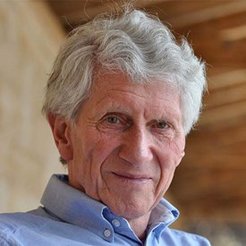The institute mourns the loss of Kenneth C. Holmes

Ken Holmes was born in England. He studied physics at Cambridge University and did his PhD at the famous Birkbeck College in London. The influence of J.D. Bernal and Rosalind Franklin there led him to discover his passion for biology, and he worked on the structure of tobacco mosaic virus (TMV) using X-ray diffraction. These formative years were followed by stays at the labs of Carolyn Cohen in the USA and of Hugh Huxley at the MRC lab of Molecular Biology in Cambridge. There he found the crucial first evidence that the form of the so-called crossbridges of the myosin filaments in muscle could change, depending on the presence of absence of ATP.
He was only 34 when he was offered a position in Heidelberg, and he moved there from Cambridge in 1967. By that time, he had already had formed contacts at the MPI in Tübingen, through his work on viruses. Because he was so young, he was initially accorded only the status of leader of a guest department of biophysics: it was only in 1973 that he was appointed Director. His interest in muscle contraction accompanied him to Heidelberg. He was concerned to find ways of characterizing the structural changes occurring when a muscle actively contracts, for which the intensity available from conventional X-ray sources was not sufficient. Ken realized the potential of the intense X-rays of the synchrotron, which were a mere waste product of high energy accelerators. At DESY in Hamburg he and his Heidelberg colleagues used for the first time the intense radiation for low-angle diffraction measurements from muscles fibres.
In the 1970s Ken saw the enormous potential of synchrotron radiation for biological research, and built at DESY the world’s first beamline for protein crystallography. This led not only to the founding of EMBL but revolutionized structural biology. Synchrotron radiation is now an indispensable part of structural biology and has in the meantime led to countless breakthroughs.
Ken’s interest now focussed on the atomic structure of the muscle proteins myosin and actin. The crystallographic determination of the atomic structure of actin was a great challenge: crystals of the monomer were available, but the cell parameters varied unpredictably. Despite these difficulties he and his colleagues succeeded in 1990 in finally demonstrating not only the structure of the monomer but also its structure and orientation in the intact actin filament. The methods used later found application far beyond the specific use in connection with muscle.
Relatively soon afterwards, the work of others provided the first atomic structure of myosin, the second main protein of muscle. However, this information provided no clear indications regarding a possible change in conformation of the myosin-actin complex, such as might underlie the stroke of the crossbridges in a contracting muscle. Ken embarked on a detailed study of the structures and of those of related ATPases, and was finally able to identify the crucial change and its coupling with the hydrolysis of the bound ATP molecule. Ken’s studies of the two proteins thus finally converged on an explanation of the mechanism of muscle contraction.
Ken’s unconventional approach to running his department and the trust which he placed in the members of his team created an atmosphere for exceptionally successful research. His spirit will always be with us.
